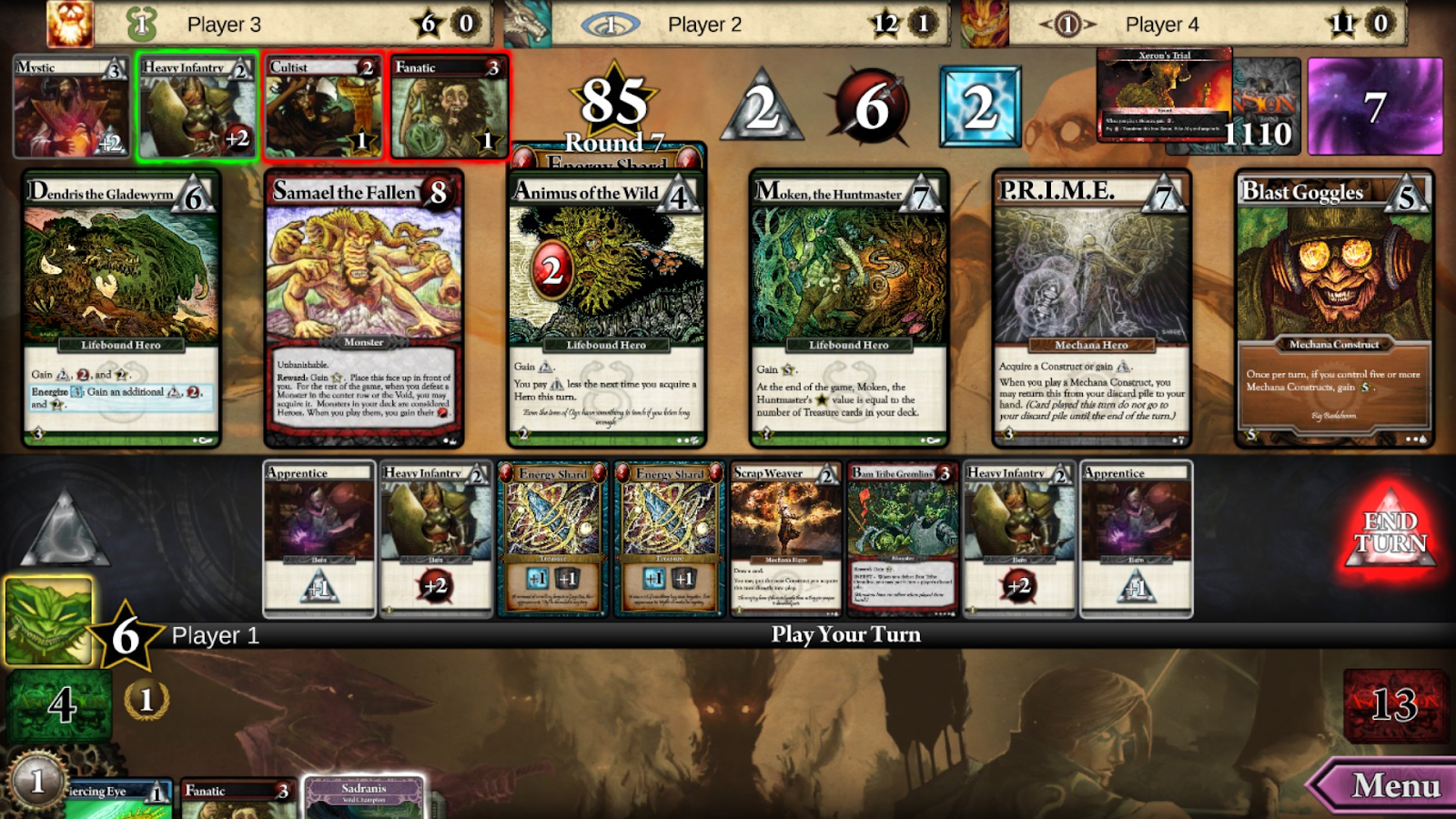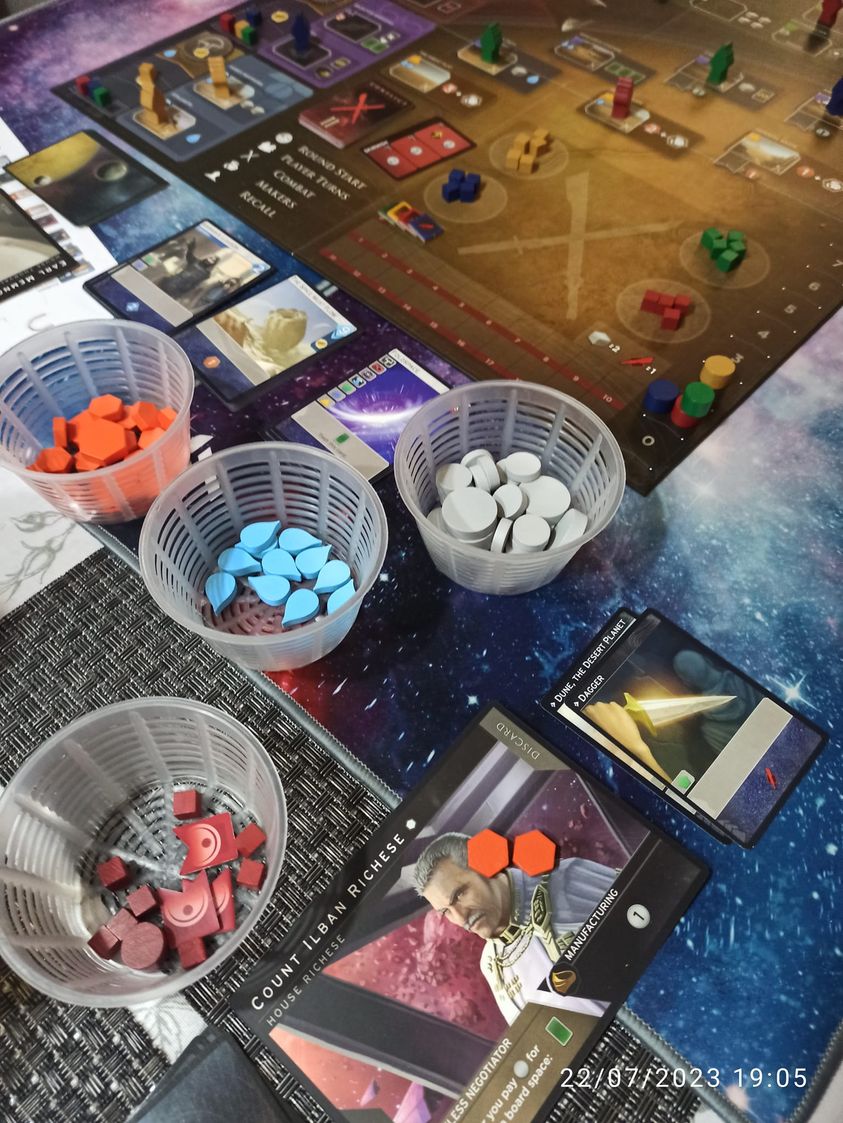So as summer comes to its annual
conclusion, I decided to return to the roots of BGHaven and focus instead on an
aspect of board gaming that I find consistently problematic. I am referring to
the matter of player counts. There is a fine line between what can be
considered a manageable, enjoyable game and a behemoth of a game with
significant downtime verging on the intolerable. What I am hinting at here is
the notion of the duration of a turn of play versus an optimal player count
that does not lead to substantial downtime. As you will appreciate, turn-taking
is subject to the ease with which players progress through a turn, the number
of options and/or decisions faced during any given turn, as well as other
contributing factors such as individual characters and propensity to overthink
actions. So the issue does present itself as a composite of factors that manifest
as a complex intertwined mesh of actions and processes.

To better understand the
complexity of the matter, you need to break down a board game into its
constituent components. When players engage with a board game during a session,
they are essentially engaging their attention on many levels.
1. They
will typically manipulate gaming components in specific ways. There is a tactile
element to the process, which is used primarily to remind the player of the
initiation, ensuing decision process and completion of a given turn. I also include
any upkeep tasks carried out in preparation for the subsequent round.
2. They
will refer to a set of rules linked to the game to execute the manipulations
required during any given turn.
3. Depending
on the ruleset, players will also be expected to interact with other players as
part of their turn. This interaction increases when one considers cooperative
games that demand a certain amount of discussion before a final decision is
taken by the active player.
4. In
most cases, they will experience a certain amount of player downtime in between
turns.
5. This
downtime could be caused by any, or all, of the following issues.
a.
It could be caused because of the number of
actions that would need to be taken per turn.
b.
It could be caused consequently by the learning
curve required to fully understand the game.
c.
It could be caused because of indecision on the
part of the active player which could in turn lead to a situation termed analysis
paralysis.
Now that I have framed the interactions
that are necessary during gameplay, let’s see how each of them could contribute
towards establishing the ideal number of players.
So, while listed as point (1)
above, the physical manipulation of gaming components is normally expected to
happen following some rules-based decision taken by an active player. This
physical manipulation can be a) preparatory, b) execution or c) housekeeping in
nature. Preparatory actions are those actions taken mechanically, in line with
game rules, but antecedent to the actual action taken by the player.
Execution-based manipulation of components occurs when the active player
decides what action to take on his or her turn. This is a manipulation players
take for granted, as necessary, for the execution of a turn. Then there is the
housekeeping manipulation of components. This takes place once the execution phase
has been executed affecting the game state for that player.

Given these listed stages, one
needs to appreciate that the more components a player needs to uniquely
manipulate per turn, the more actively these actions will impact the duration
of a turn. While it is tempting to design games that employ several components,
the impact on turn duration needs to be kept actively in check. The reason here
is obvious since there is a direct relationship between the turn duration for a
given player and the downtime for the other players involved in a game.
The second point listed above
refers to the ruleset employed. It is appreciable that the more extensive and
unnecessarily verbose a ruleset, the steeper the learning curve. Keeping rules
simple is an art unto itself. Yet some designers tend to forget this undeniable
truth. Most of the timeless board game classics, that have survived the test of
time, have the shortest rulesets. Think how simple it is to teach the rules of
Checkers, Chess or Nine-Man Morris, it all boils down to stripping a game to
its simplest purest form.
Some will argue that the purpose
of a ruleset is not solely to explain the movements and processes but rather to
weave a virtual world around the players, establishing context and purpose.
For, apart from pure abstract strategy games, most games are built on a premise
or theme that aims to weave a virtual world around the players, a fantastic
illusion within which the game exists. I posit that this can still be achieved
without standing in the way of clarity or ease of use. Ease of use is key here.
During active play, participants need to find it easy to access key rules to
determine the legitimacy of an action. This is more important during the early
stages when players are still learning how to play. If the rules are unclear,
interspersed with game-specific jargon or irrelevant blocks of text, they will
become stumbling blocks rather than assist the flow of play. So, should
designers simply give up on creating eye-catching or thought-provoking themes?
Not at all! On the contrary, the theme or virtual world built should be offered
a space but one which must in turn give way to practicality and common-sense
design concepts. For example, the rulebook could be structured in such a way as
to follow a logical and rational representation of the gaming process. Let us
for a moment consider the following sequence:
1. Brief
introduction highlighting the world within which the game exists.
2. A
concise description of the game objectives and win conditions
3. A
review of the components used.
4. A
clear description of the setup process
5. A
breakdown of turn-taking including sequence of actions, available choices, and
final housekeeping on turn conclusion.
6. A
comprehensive glossary of terms used within the scope of the game.
7. A
breakdown and illustration of any game-specific iconography used.
8. An
appendix offering a more in-depth foray into the world within which the game
exists including any histories or flavour texts as required.
You will note that the structure
puts more emphasis on pushing relevant gaming materials at the front of the
rulebook with any further materials relegated towards the end of the
publication. This is not the perfect
sequence but close enough. Some ruleset creators may, for instance, relegate
points 6 and 7 to the very end of the rulebook for practical reasons. Others
may opt to segregate the appendix mentioned in point 8 as a separate companion
booklet further contracting the length and content of the main ruleset. Others still may decide to create flashcards that
summarise the turn-taking noted in point 5 as well as offer a summary of
iconography used on the same flashcards. These are all stratagems aimed at
simplifying the learning process and thus rapidly reducing downtime to what is
essential for the game to proceed at a brisk pace. The third point raised above
is player-to-player interaction. Along general lines, all games will demand
some manner of player-to-player interaction, it's only the extent of the
interaction that varies. In classical, two-player abstract games, interaction
is mostly limited to responding to an opponent's moves once these have been
completed. Yet in a modern Eurogame, the levels of interactions can be several,
ranging from well-thought countermoves to specific actions taken which may or
may not be directly influenced by an opponent's actions, to resource and worker
management.
If we consider cooperative games,
this level of player-to-player interaction necessarily balloons. Here players
are encouraged to exchange ideas and opinions which could inform the final
decision taken by the active player. The deeper the players are into a
cooperative game, the more intense these discussions can get. While I have
never been in a situation where time was called to hasten the decision process
in a cooperative game, we got close!
All this leads to the notion of
downtime. Reducing the amount of unproductive downtime is a real concern in
most game designs. If players disengage from a game because they have nothing
to do but wait, you have a real problem. Downtime can, in turn, be either
“perceived” to be so on account of a player not fully appreciating the game, or
“actual”, in the sense that even if the other players are efficient in
executing their turn of play, the number of manipulations is such that downtime
is still significant. While there is nothing one can do to address the former,
actual downtime can be tackled by one of two methods.
At a very simple level, actual
downtime can be reduced by reducing the number of actions needed to complete a
turn. If a player needs to complete fewer actions to complete a turn, then the
downtime experienced by the other players will be less. Another simple way to
reduce downtime is to reduce the player count. This makes sense in that if you
have a four-player game with each player taking two minutes to complete a turn efficiently,
then each of those four players will have to experience a downtime of six
minutes before they can get back to executing their next turn. There again I am
assuming efficient play, if any of those four players take longer to execute a
turn then the downtime will grow accordingly.
I have seen the effect of turn
duration on player downtime in quite a few board games but nowhere was it more
obvious than in deck builders like the card game “Ascension”. The game starts
quite snappily, mostly because each player starts with a relatively small,
standard, 10-card deck. The situation, however, does not last as, turn after
turn, players acquire additional cards from the common marketplace. Added to
that, the acquired cards can offer added actions when they are played, and each
turn can become an extended process of cards calling out more cards which in
turn leads to further actions. In a two-player game, the drawn-out turns,
towards the latter stages of a match, can be considered quasi-acceptable. At
higher player counts, however, it could turn into a downtime purgatory.

Yet there is one kind of action, which could be
enacted by the active player, which is not easy to control. This is the time
spent by the player in active deliberation, often consequently to indecision,
sometimes termed “analysis paralysis”. Here we have a situation where a player
ends up taking a disproportionate amount of time weighing options before
deciding what action or line of thought to pursue. There is no real remedy to
this phenomenon since this is often linked to an individual's character. Yet it
is possible to perhaps curtail the negative effects by actively encouraging
players to take shorter turns. This could be achieved to an extent by endorsing
planning and being more decisive during their turn-taking. In extreme
situations, analysis paralysis could affect the other players adversely.
In particularly severe situations, the game coordinator could advocate the use
of an egg timer to force the player to act and conclude the turn. One hopes
that these situations never arise, but egg timers or stopwatches could become
necessary if the offender keeps holding back gameplay with excessive
deliberation time.
So, what can we take away from
all this? Well, principally the number of game components, ruleset complexity,
turn duration and by association downtime, can strongly influence the
playability or enjoyability of a game at a given player count. Yet a balance
needs to be struck by the designers between integrating enough actions to make
a game engaging, while at the same time catering to the number of players
necessary to make the game work. As we shall see, striking this balance can be
achieved in various ways.
In truth, there are a few design
hacks aimed at reducing downtime with higher player counts. For instance, some
designers opt for some actions to be taken simultaneously or some actions could
be taken in between turns or on other players’ turns. However, this stratagem
may not always be feasible and may make sense only in so far as the selected
actions do not offer one-sided advantages to the active player.
Another mechanism often
implemented, and somewhat reminiscent of what I have just mentioned, is to
offer piggyback actions
on the decisions made by the current, active player. Here I would like to point
out Tiny Epic Galaxies, which uses this mechanism in its gameplay. Furthermore,
to reduce downtime, actions could be aggregated or moved to the upkeep or
housekeeping stage of a turn. In this latter stage, no active decisions would
be required, hence reducing downtime.
When cards are drawn, or actions are taken,
towards the end of a turn, there will be a tendency for a player to work on the
cards received “in between” their turns rather than “on their turn”. This will
have the effect of keeping them engaged as they plan for their next turn, and
they will also have a higher incentive to observe the plays made by others. The
overall result is that of reducing perceived downtime by increasing player
involvement.
However, there is a counter side to this
strategy. Some players do not look forward to further decisions in between
turns. These players see downtime as an opportunity to chat, stretch, or just disengage
from the action at the table. In the case of these players, you will notice a
tendency to adopt an aloof and detached approach to end-of-turn housekeeping to
the point that they will frequently delay reviewing any new material or
information right to the last possible second. Doing so, they end up still
carrying out most of their decisions when the action at the table returns to
them.

This brings us full circle to the purpose of, and
limitations to, downtime. In most board games, downtime is fundamental to offer
players some breathing space. At the
same time, gamer psychology plays an equally important role in the perception
and utility of downtime. Players who are “always on” will find unnecessary
downtime tedious. On the other hand, players who know how to utilize that same downtime
to prepare for their next move could benefit from it. This does not mean that
designers should not pay attention to curtail unwarranted downtimes but that
they should aim for a style of action optimisation that does not impact
gameplay.
To be fair with some of the best board game
titles out there, this aspect of balancing downtime and player count is mostly
taken seriously. Yet I feel that some titles fail to properly address the
matter and present board games that essentially do not scale up properly from 2
to 3 or 4 players. What I normally do when I realise that a game works better
at lower counts is to put a marker or reminder within the box for the next time,
I play the game.
This is because, in truth, the player count on
the box can be misleading. In most instances, the best way to determine the
ideal player count is to playtest the game with different numbers of players. However,
there are some further pointers you could use to guide you during the playtest
which could save you some time.
Start by looking at the mechanism used in the
board game under consideration.
For example, a game that requires lots of player
interaction may work better with a larger group, while a game that utilises
individual player boards may fare better with a smaller group. There are
exceptions of course but along general lines this premise holds. A game like
Mysterium for instance works best with larger player counts whereas games like
Wingspan are ideally played with smaller player counts. I prefer 3-4 players
for the latter and most probably 2- 3 players if you want to play a relaxed
game with little downtime.

As can be seen from all I have presented here,
addressing downtime is a complex affair that needs a holistic approach to be
resolved. I have noted that changes to the ruleset or how these are presented
could help reduce downtime. I also pointed out that depending on the mechanisms
chosen, downtime itself could be used to carry out actions that might help
reduce player inactivity in between turns. Yet there is so much one can do by
tweaking rulesets and gaming mechanisms. To ensure downtime is kept to
essentials one must also address time lost due to analysis paralysis. We saw
that this too can be curtailed by adopting various strategies like the
introduction of a timer as well as properly structuring rules and actions to
facilitate understanding and learning.
Before concluding
this foray into player counts and downtime, I wish to stress that despite what
I have said here, there are games that truthfully reflect the player count as
well as the anticipated game duration. Yet I feel that many designers need to
clarify that their statements are a best-case scenario and do not reflect
the realities faced by new players who might have just cracked open a board
game for the first time. From experience, I think it would be fair to say that
for first-time players, the game duration could be anywhere from two-thirds to
twice as long as the duration reported on the box itself. For instance, a
45-minute game will most likely last 70 minutes, whereas a 120-minute game
could well last close to 200 minutes when played for the first time.
I hope that you have found this foray into board game
player counts both interesting and informative. I also hope that it will help
to guide and inform your decisions when it comes to selecting a new board game to
play with your gaming group. Principally
remember that you could face a situation where the recommended number of players
on the box may not always be the optimal one when you sit down to play. Also, you
can arrive at a realistic, optimal player count by considering “player turn
duration” as well as downtime. Also, keep in mind that character and player
psychology will impact both turn duration and downtime and that you may wish to
take this into consideration when recommending a board game to a gaming group
or determining the ideal player count. Ultimately try to bear in mind that playing
a board game with first-time players will take longer than what it says on the
box, so plan extra time for that. More importantly, always discuss these
matters with your gaming group to make sure that expectations are met and that
everyone has a great time.





























